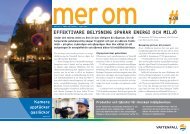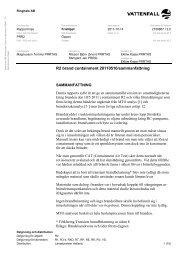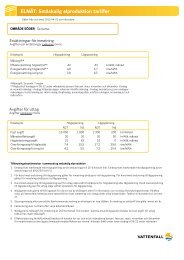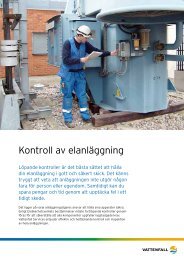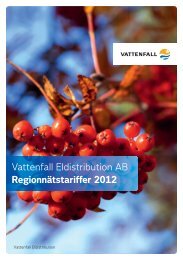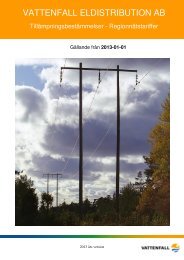This environmental impact assessment for Kriegers flak ... - Vattenfall
This environmental impact assessment for Kriegers flak ... - Vattenfall
This environmental impact assessment for Kriegers flak ... - Vattenfall
Create successful ePaper yourself
Turn your PDF publications into a flip-book with our unique Google optimized e-Paper software.
130 CONSEQUENSES OF THE WIND FARM<br />
12.4.3 Birds<br />
The occurrence of birds is described in Chapter 11.6.3.<br />
12.4.3.1 Impact<br />
The wind farm may give cause to the following <strong>impact</strong><br />
on birds:<br />
a) Risk of collisions<br />
b) Disturbance of staging and <strong>for</strong>aging water fowl<br />
c) Barrier <strong>for</strong> migrating birds<br />
d) Loss of habitat<br />
a) Risk of collisions<br />
In theory, all birds ß ying below 200 metres are subject<br />
to the risk of collision. Looking at the radar measurements<br />
carried out by the company, between 60 and 64<br />
% of birds registered during day time, belong to this<br />
category. For birds registered during night time, the<br />
number was 30 to 39 %.<br />
Birds migrating during day time will be less affected<br />
as they can see the hazards earlier and ß y<br />
around them.<br />
As the wind turbines will be ß oodlit, it will in<br />
general also be possible to see them during night time.<br />
Critical situations with added collision risk will primarily<br />
occur during the night with sudden fog/rain or<br />
strong winds occurring.<br />
Studies of collisions between birds and wind turbines<br />
constitutes a lot of the material that deals with<br />
the <strong>impact</strong> of wind turbines. European studies show<br />
that the <strong>impact</strong> of wind turbines on birds through collisions<br />
are minimal in the areas that have been studied<br />
and in the habitats that are of interest <strong>for</strong> establishing<br />
wind farms. These studies have been criticised <strong>for</strong> having<br />
been made in areas with single turbines and often<br />
burdened by some sort of methodical problem, making<br />
the results difÞ cult to interpret.<br />
A recent study of the risk of collision at Utgrunden<br />
and Yttre Stengrund (Jan Pettersson and Thomas Stalin)<br />
however shows that even in the case with a greater<br />
number of turbines (seven and Þ ve respectively), the<br />
collision risk is minimal.<br />
Be<strong>for</strong>e the seven wind turbines at Utgrunden were<br />
installed, about 40 % of ß ights of a total of 125 058<br />
eider ducks, ß ew in the area where the turbines later<br />
were installed. When the wind farm had been installed<br />
only 6 % of 192 751 (spring of 2001) and 7 % of 211<br />
239 eider ducks (spring of 2000) ß ew through the area.<br />
Observations at Utgrunden wind farm<br />
Investigations at Yttre Stengrund showed the same<br />
pattern. During the autumn of 2000, be<strong>for</strong>e the installation<br />
of the wind turbines, 32 % of eider ducks under<br />
ß ight ß ew through the area where the turbines later<br />
were erected. During the autumn 2001, when the turbines<br />
had been erected, only 2 % ß ew through the area.<br />
Radar investigations were carried out during night<br />
time and showed that the birds identify the turbines in<br />
the dark and that they avoid them in the same way as<br />
during day time.<br />
Investigations at Utgrunden and Yttre Stengrund<br />
showed that the birds, both during day and night time,<br />
seemed to detect the turbines at a distance of 2 km.<br />
The birds chose to pass at a relatively big distance of<br />
500 to 1 000 metres from the turbines. Which side<br />
of the wind farm that the birds chose depends on the<br />
wind direction. It is very rare that the birds chose to<br />
ß y above the wind turbines. During the whole time of<br />
investigation, not a single collision was observed (see<br />
picture on next page).<br />
No collisions were observed during visual observations<br />
during day time at the Danish wind farms Horns<br />
Rev and Nysted.<br />
The radar investigations carried out at Horns Rev<br />
showed that only between 14 and 22 % of the birds<br />
chose to ß y through the wind farm. At Nysted, the corresponding<br />
Þ gure was 9 %.





